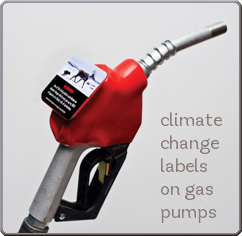To know the price of everything and the value of nothing
“We can’t solve problems by using the same kind of thinking we used when we created them.”- Albert Einstein
Heads at the World Bank and the International Monetary Fund recently made headlines when they suggested that we need to let the true cost of fossil fuels be reflected in their price. The Globe and Mail summarized their views: “Achieving a predictable price on carbon that accurately reflects real environmental costs is key to delivering emission reductions at scale. Correct energy pricing can also provide incentives for investments in energy efficiency and cleaner energy technologies.”
Whether it’s through carbon tax or cap-and-trade mechanisms, the consensus among politicians, economists, and environmentalists seems to be that we need to have the price of fossil fuels reflect their true cost. But what does this actually mean? And what are the assumptions upon which this view is founded? And, most importantly, will it work?
“… accurately reflects real environmental costs… “
To appreciate this sentence, you must first understand the concept of externalities. Simply put, externalities are costs or benefits that are experienced through the use of a good or service and are not reflected in that good or service’s price. Capturing the “real environmental costs” of fossil fuels means that we have to internalize the harms associated with their use to have them reflected in price.
Knowing the price of everything and the value of nothing.
Pricing externalities means that if burning of fossil fuels is going to result in the loss of a species, we need to first establish the dollar value of that loss, then take this figure and spread it over all the fossil fuels we consume. This way, the cost is incorporated into the price of the product. For example, as the climate in our north changes, freezing rains are locking lichen under sheets of ice. The caribou that survive off this food source normally brush snow aside to access it but, because of our actions, it slowly starves; desperately trying to stomp through ice to access food that is visible but no longer as accessible. Pricing this cost at the pump means that you may be able to wipe out this species for a fraction of a penny.
What is the price of a human life?
Ultimately, this is the question that the head of the IMF and the World Bank and anyone who proposes similar regimes must answer. If climate change will cause drought, crop failure, human starvation and death, we must first put a dollar value on human life in order to have that cost reflected in the price of fossil fuels. “What is the price of a human life?” is the uncomfortable question that no reporter ever asks and it’s the inconvenient truth that climate change advocates often ignore. Moreover, after you’ve internalized this cost in the price of the product, the morally-problematic implication is that you can “purchase” that harm so long as you pay the correct price per litre.
Our unexamined world view
The idea of internalizing costs by way of a carbon tax or cap-and-trade regime is premised on a particular world view that says humans are rational, self-interested, all-knowing wealth maximizers that respond to price signals like automatons. But is that what we are? Or are we complex beings that also respond to moral information? If your framework is the former, you will develop solutions proposed by the IMF, World Bank, and the oil industry. If your beginning point is the latter, you will arrive at the market mechanism proposed by Our Horizon.
A simple warning sticker on a gas pump nozzle.
Our idea is simple: warning labels on gas pump nozzles like those on tobacco packages. The concept connects a behaviour with its consequence right at the point of purchase. It is a market mechanism that captures and communicates cost in a qualitative way. In pricing life, the IMF and World Bank solutions devalue life. Our solution is life-affirming. It provides information to the marketplace to engage our sense of humanity in a way that a 10-cent price increase at the pump never could.
Our idea is also consistent with the writings of economist Adam Smith. He wrote, “By acting according to the dictates of our moral faculties, we necessarily pursue the most effectual means for promoting the happiness of mankind.” Indeed, it is our moral sense of right and wrong that regulates the pursuit of our individual self-interest to allow the invisible hand to operate. Our label inserts feedback into our economic system to provide the moral information we need to allow the invisible hand to promote “the happiness of mankind.” In practical terms, our idea has the potential to move us from whining about increases to the price of gas to demanding we stop endangering the health of our planet.
But price is the only thing that will change behaviour!
If this is your reflex, you’ve drunk the Kool-aid. We must consider pricing mechanisms in the context of what is politically feasible. In Canada, the idea of a carbon tax is so contentious that our federal government has actually said it would “kill and hurt Canadian families“. Unfortunately, given our political reality, we’re never going to see the “real environmental costs” reflected in price. Our situation is such that the best we’re ever going to see is marginal increases to price that are unlikely to have much impact on behaviour.
While the price of gasoline has been increasing over the last several years, a report by TD Economics observes that “the overall fuel economy in Canada has remained fairly flat over the past decade.” TD’s findings suggest that increases in price can initially lead to the purchase of more fuel-efficient vehicles but that we quickly adapt to the new norm and carry on living as usual. There is also interesting research that shows that pricing externalities has a tendency to commodify and can “often switch off moral behaviour.” So an inadequate price increase may result in a double-whammy: (1) it may fail to change behaviour in a meaningful way and (2) it risks making us feel like we’ve already paid for the harm and are therefore less likely to consider the moral implications of our behaviour.
We’re running out of time with climate change.
Ask yourself: is adjusting the price of gas from $1.25 /L to $1.35 /L going to be what saves us from what the UN Secretary-General Ban Ki-moon has called “the moral challenge of our generation”? Are we going to look back 10 years from now and say, “That extra dime really turned the tide around on climate change”?
Einstein would say that the prevailing solutions are based on the same sort of thinking that got us into this mess. If you follow climate change, you know what we’re up against and you know how much time we have left. We need something to shake us out of our sense of complacency. Our Horizon‘s globally-unprecedented warning label campaign is it.
A first and necessary step
The first and necessary step in any transformation is to honestly face up to one’s challenge. Our label at the pump is a mirror that reflects back our behaviour. It forces self-reflection and opens up a necessary space for meaningful change.
Click here to contact your local representative and tell them to pass a by-law that requires gasoline retailers to place warning labels on their gas pump nozzles. The first community in Canada to do this will set a global precedent that may have the power to shape the course of human history.
If you would like to contribute to our campaign, click here or contact robert@ourhorizon.org. We are currently seeking major supporters.
Filed in: blog












